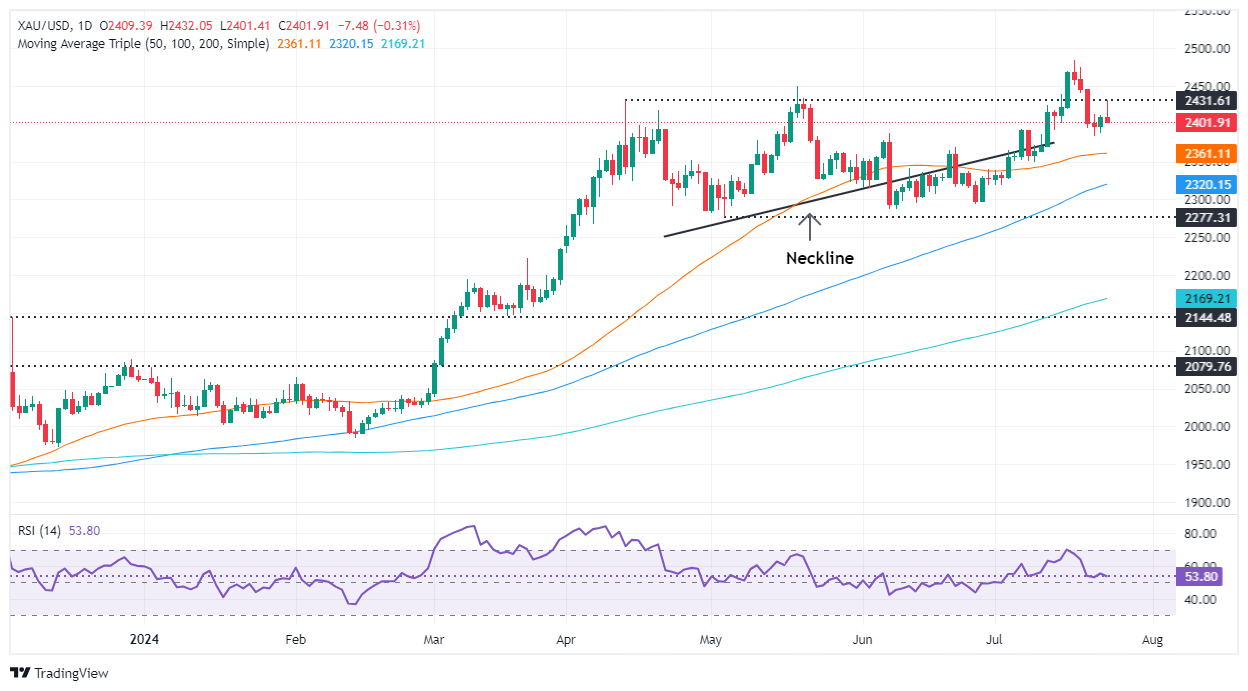Gold price retreats beneath $2,400 as traders await US data
- Gold touches $2,432, then stabilizes under $2,400, pressured by US 10-year yields at 4.274%.
- FedWatch Tool forecasts 100% chance of a 25 bps rate cut in September, bolstering gold.
- India slashes import tax on precious metals, spurring demand; key US GDP, PCE data due Thursday.
Gold price is virtually unchanged late in the North American session, set to end the day around familiar levels below $2,400 after hitting a daily high of $2,432. Risk-aversion and rising US Treasury bond yields seem to have capped the non-yielding metal rally, which usually retreats as investors flock to US Treasuries.
Bullion traders lifted spot prices while US Treasury bond yields edged lower ahead of a US five-year note sale auction. Afterward, the US 10-year Treasury note coupon rose two basis points to 4.274%, a headwind for the golden metal. Meanwhile, the buck remains on the back foot, yet losses are trimmed as measured by the US Dollar Index (DXY). The DXY edges down 0.08% at 104.38.
Risk-off mood helped Gold buyers lift spot prices to a three-day peak, as traders had fully priced in a 25-basis point (bps) rate cut by the Federal Reserve at the upcoming September meeting.
The CME FedWatch Tool shows odds of a quarter of a percentage point cut at 100%, while data from the Chicago Board of Trade (CBOT) sees market participants estimate 53 bps of easing for 2024, via data of the December 2024 fed futures rate contract.
Data-wise the US economic docket revealed the Goods Trade Balance for July printed a narrower deficit than expected. Meanwhile, business activity as measured by the Purchasing Managers Index (PMI) report revealed by S&P was mixed, with manufacturing contracting for the first time since first time since December 2023.
Precious metals were also boosted by India’s decision to cut import taxes from 15% to 6%.
Traders brace for the release of the first reading of the Gross Domestic Product (GDP) for Q2 2024 in the United States (US) on Thursday. This would be followed by the release of the Fed’s preferred gauge for inflation, the Personal Consumption Expenditure (PCE) Price Index figures for June.
Daily digest market movers: Gold price remains glued to the $2,400 figure
- S&P Global revealed that Services and Composite PMIs for July exceeded estimates, coming at 56 and 55, with the former exceeding expectations of 55.
- The S&P Global Manufacturing PMI dropped from 51.6 to 49.5, missing the consensus of 51.7.
- The US Goods Trade Balance Advanced for June came at $-96.0 billion, below the $-98.0 billion and less than May’s $-99.4 billion.
- The Gross Domestic Product (GDP) for Q2 is projected to rise from 1.4% in Q1 2024 to 1.9% quarter-over-quarter (QoQ), indicating that the economy is accelerating as the year progresses.
- The Fed’s preferred measure of inflation, the Core PCE, is expected to dip from 2.6% to 2.5% year-over-year (YoY).
Technical analysis: Gold price falls below Tuesday’s high
After forming a ‘bullish haram,’ Gold prices hit a three-day peak above $2,430 but have retreated below the July 23 high of $2,412, hinting at buyers' lack of strength. A daily close below the latter could expose XAU/USD to further selling pressure, though US data would drive price action on Thursday and Friday.
The Relative Strength Index (RSI) is bullish, although the slope has turned flat, indicating buyers' and sellers' lack of direction and commitment.
XAU/USD needs to clear Wednesday’s peak at $2,430 for a bullish continuation. Once surpassed, the next resistance would be $2,450 before challenging the all-time high of $2,483. Up next would be the $2,500 figure.
Conversely, if XAU/USD tumbles below the July 22 low of $2,384, a deeper correction is on the cards. The next support would be the 50-day Simple Moving Average (SMA) at $2,359. Once sellers clear the 100-day SMA at $2,315, further losses are seen before falling toward $2,300.

Gold FAQs
Gold has played a key role in human’s history as it has been widely used as a store of value and medium of exchange. Currently, apart from its shine and usage for jewelry, the precious metal is widely seen as a safe-haven asset, meaning that it is considered a good investment during turbulent times. Gold is also widely seen as a hedge against inflation and against depreciating currencies as it doesn’t rely on any specific issuer or government.
Central banks are the biggest Gold holders. In their aim to support their currencies in turbulent times, central banks tend to diversify their reserves and buy Gold to improve the perceived strength of the economy and the currency. High Gold reserves can be a source of trust for a country’s solvency. Central banks added 1,136 tonnes of Gold worth around $70 billion to their reserves in 2022, according to data from the World Gold Council. This is the highest yearly purchase since records began. Central banks from emerging economies such as China, India and Turkey are quickly increasing their Gold reserves.
Gold has an inverse correlation with the US Dollar and US Treasuries, which are both major reserve and safe-haven assets. When the Dollar depreciates, Gold tends to rise, enabling investors and central banks to diversify their assets in turbulent times. Gold is also inversely correlated with risk assets. A rally in the stock market tends to weaken Gold price, while sell-offs in riskier markets tend to favor the precious metal.
The price can move due to a wide range of factors. Geopolitical instability or fears of a deep recession can quickly make Gold price escalate due to its safe-haven status. As a yield-less asset, Gold tends to rise with lower interest rates, while higher cost of money usually weighs down on the yellow metal. Still, most moves depend on how the US Dollar (USD) behaves as the asset is priced in dollars (XAU/USD). A strong Dollar tends to keep the price of Gold controlled, whereas a weaker Dollar is likely to push Gold prices up.
Forex News
Keep up with the financial markets, know what's happening and what is affecting the markets with our latest market updates. Analyze market movers, trends and build your trading strategies accordingly.
